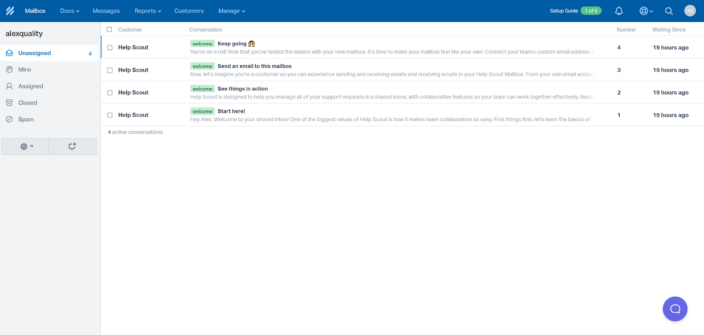Help Scout, has been a go-to tool for many businesses. However, as customer needs grow more complex, the search for a Help Scout alternative became essential. This guide aims to explore the best Help Scout alternatives, focusing on their superior features and improved customer service capabilities.
Why consider alternatives to Help Scout?
While Help Scout has simplified customer service, it might not be the perfect fit for every business.
Here are some reasons why businesses turn to Help Scout competitors.
- Limited features – some businesses find Help Scout’s toolkit limiting, especially when they require advanced functionalities or specialized features for their operations. Help Scout can be somewhat limited when it comes to advanced ticket routing and extensive reporting.
- Integration constraints – although Help Scout offers a number of integration options, there are some project management tools missing.
- Cost implications – while Help Scout’s design is streamlined, the pricing might be a concern for smaller businesses with tighter budgets.
It’s essential for businesses to choose software that addresses their particular needs, especially given the impact of negative customer experiences. Exploring alternatives could lead to a tool that better aligns with a company’s specific goals and challenges.
| Platform | Capterra rating | Integrations | Free version | Free trial | Price range |
|---|---|---|---|---|---|
| LiveAgent | 4.7 | 220+ | ✅Yes | ✅Yes | $15 agent/m |
| HubSpot Service Hub | 4.4 | 1000+ | ✅Yes | ✅Yes | $45/agent/m |
| Jira Service Management | 4.5 | 3000+ | ✅Yes | ✅Yes | $22.05/agent/m |
| TeamSupport | 4.5 | 20+ | ✅Yes | ✅Yes | €15/agent/m |
| Freshdesk | 4.5 | 1000+ | ✅Yes | ✅Yes | $21/agent/m |
10 Help Scout competitors and alternatives
While Help Scout has solidified its place in the realm of customer support, the dynamic and evolving needs of businesses today mean there’s always room for alternatives. In our exploration of the top 15 Help Scout alternatives, we’ve taken a deep dive into:
- Pricing: Is it cost-effective, and does it provide value for money?
- Differentiation in features: What makes each of these tools stand out from the rest?
- Pros and cons: What are actual users saying about their experiences?
- Integration capabilities: The tool’s ability to integrate with other essential business applications.
- Industries: What industries could benefit the most from the software?
With that in mind, let’s get started!
Table of contents
- Liveagent
- HubSpot Service Hub
- Jira Service Management
- TeamSupport
- Freshdesk
- Zoho Desk
- Intercom
- Zendesk Suite
- Front
- Crisp
1. LiveAgent
LiveAgent distinguishes itself as a robust Help Scout alternative with an adaptable, cost-effective help desk platform with over 175 features, user-friendly interface and affordable pricing. Additionally, LiveAgent offers reliable 24/7 customer support, catering to all users.
Adding to its appeal, LiveAgent integrates seamlessly with over 200 third-party applications. Some of its key integrations include the likes of Shopify, WooCommerce, Magento, Jira, Slack, Pipedrive, Zoiper, and Salesforce.
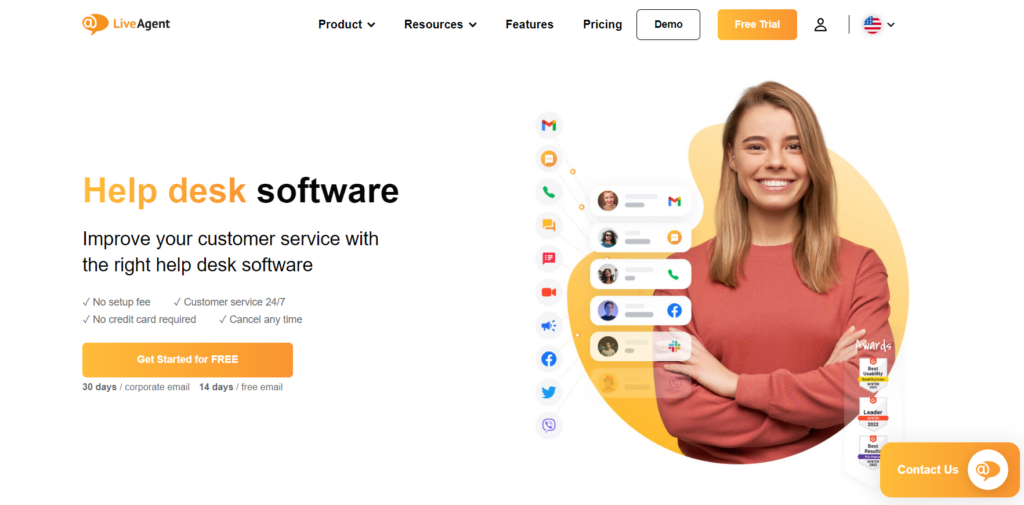
LiveAgent stands out as one of the best Help Scout alternatives from the price point to the excellent customer service they provide. Considering that the first contact resolution rate on call centers is between 70-75%, LiveAgent’s call center feature is an absolute must-have if you want to deliver assertive customer support without the need for follow-ups.
The bottom line is that if you are looking for an easy-to-set-up, affordable, and well-supported all-in-one helpdesk solution, LiveAgent is the way to go.
LiveAgent features
Features common to LiveAgent and Help Scout:
- Omnichannel communication
- Integrated live chat
- Advanced ticketing system
- Extensive automation options
- Universal inbox
- Knowledge base
- Self-service portal
- Team collaboration tools
- API
- Canned responses
Features not present in Help Scout:
- Advanced reporting and analytics
- Social media channels
- Call center capabilities
- Activity tracking
- Audit trail
What are the main differences between LiveAgent and Help Scout?
- Call center capabilities: LiveAgent offers built-in call center capabilities, streamlining phone-based customer service and consolidating reporting, while Help Scout lacks this functionality, requiring additional solutions for phone support.
- Extensive social media integration: LiveAgent integrates with more social media platforms than Help Scout, allowing businesses to handle support directly from social media channels.
- Real-time analytics: LiveAgent provides real-time analytics and reporting, enabling businesses to respond quickly to trends and issues based on customer interaction data.
- SLA management: LiveAgent offers SLA management, ensuring support interactions meet service levels, whereas Help Scout lacks this feature.
Pros
- No need to purchase additional products with the all-in-one solution
- Affordable pricing structure with a 30-day free trial period
- Multilanguage features and language-adaptable widgets
Cons
- Unable to log into two browsers with the same account at the same time
- Tech support is available 24/7, but it is located in the EU
Best for small to medium businesses
LiveAgent’s all-in-one customer service solution caters to numerous industries, from the automotive field to the eSports realm. Not only does its flexibility serve small to medium-sized businesses, but industry leaders like Airbus and Huawei also implement it. LiveAgent excels across traditional and contemporary communication channels, offering suitable solutions for businesses like BMW, NASCAR, and companies in the tech-savvy eSports sector.
LiveAgent pricing
LiveAgent offers a free 30-day trial and four pricing tiers:
- Small: $15 per agent/month
- Medium: $29 per agent/month
- Large: $49 per agent/month
- Enterprise: $69 per agent/month
Customer review
“The experience from our end has been a reliable one. From implementation to usage, LiveAgent has always been at the top most level in ensuring that we are able to meet our customer support delivery needs in the best way we know how. This allows us to give our customers a satisfying experience by delivering real-time support to their inquiries and ensuring they are always contented with the services that we offer.”
Source: Capterra
Try out LiveAgent, the top HelpScout competitor, for 30 days for free and get acquainted with its features.
2. HubSpot Service Hub
As a Help Scout alternative, HubSpot Service Hub offering a robust customer service platform that empowers businesses to build better customer relationships. HubSpot Service Hub integrates seamlessly with a multitude of third-party applications including Slack, Gmail, Salesforce, and many others, enabling a highly efficient workflow.
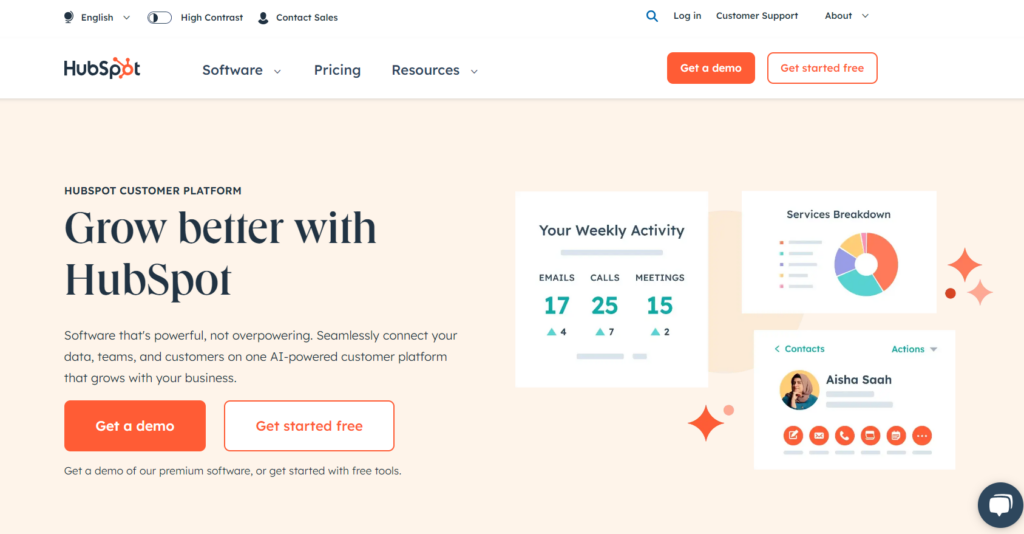
HubSpot Service Hub has many things going for it, particularly when comparing it to platforms like Help Scout. Its dynamic real-time analytics offer a detailed live snapshot of customer interactions, a feature missing in Help Scout. This means businesses can respond swiftly to emerging trends and customer needs.
In summary, if your business values real-time insights and strict service level adherence, HubSpot Service Hub is the more well-rounded choice.
HubSpot Service Hub features
Features common to HubSpot Service Hub and Help Scout:
- Customer Portal
- Knowledge Base
- Multi-Channel communication
- Live Chat
- API
- Canned responses
- Knowledge base management
- Mobile access
Features not present in Help Scout:
- Real-Time Analytics
- SLA Management
- CRM
- Geotargeting
What are the main differences between HubSpot Service Hub and Help Scout?
- Real-time analytics: HubSpot Service Hub boasts real-time analytics features, enabling businesses to monitor customer interactions and service metrics instantaneously. This advantage is absent in Help Scout.
- SLA management: Additionally, HubSpot has built-in SLA management capabilities, providing tools to define and track adherence to service level agreements. This feature is not found in Help Scout’s current feature set.
Pros
- Easy to integrate with other HubSpot products
- The UI is easy to navigate and use
- Flexible and robust knowledge base
Cons
- The subscription can get quite expensive
- Steep learning curve
- Not enough customization options
Best for medium to large businesses
HubSpot Service Hub is perfect for businesses seeking an extensive customer service platform with standout CRM features. It is ideal for medium to large enterprises needing strong customer service solutions, notably in the marketing, advertising, software, and technology industries.
HubSpot Service Hub pricing
HubSpot Service Hub is available at:
- Free tier
- Starter plan costs $45 per month
- Professional plan costs $450 per month or the
- Enterprise plan costs $1,200 per month.
Check out a full HubSpot alternative comparison and find out how it holds up against LiveAgent.
3. Jira Service Management
Jira Service Management, a part of Atlassian’s suite of products, stands out as a remarkable Help Scout alternative. Jira Service Management integrates with an extensive range of third-party applications, including Slack, Confluence, Opsgenie, and Bitbucket.
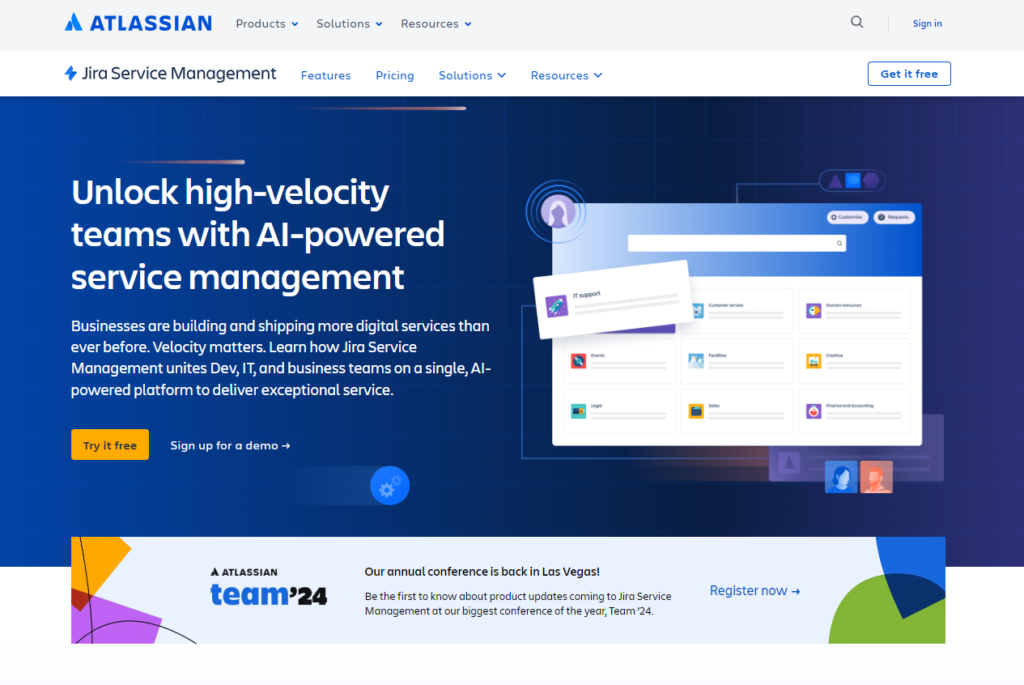
Jira Service Management holds its own as a stellar Help Scout alternative. It impresses with a customizable dashboard, superior issue management, and handy calendar management, all features that Help Scout lacks.
Jira is particularly adept for IT teams and service desks. Its ability to seamlessly track and manage issues, along with its adaptable interface and scheduling tools, gives it an edge.
In a nutshell, if you’re an IT team or a service desk seeking more tailored features, Jira Service Management could be your ideal pick over Help Scout.
Jira Service Management features
Features common to Jira Service Management and Help Scout:
- Extensive dashboards and reporting
- Multi-channel Communication
- Mobile Access
- API
- Email management
- Knowledge base management
- Mobile access
- Surveys
Features not present in Help Scout:
- Customizable Dashboard
- Issue Management
- Calendar Management
- Client portal
What are the main differences between Jira Service Management and Help Scout?
- Customizable dashboard: Jira Service Management brings forward the benefit of a customizable dashboard, a feature that’s absent in Help Scout. This allows businesses to tailor their interface based on their unique needs, enhancing usability and efficiency.
- Issue management: As a platform initially designed for issue tracking, Jira Service Management naturally excels in this area. It provides comprehensive issue management tools that outshine Help Scout, enabling teams to effectively track, manage, and resolve issues.
- Calendar management: Another distinction lies in Jira’s calendar management features. These help in planning and scheduling tasks, meetings, or deadlines more effectively, a function not present in Help Scout.
Pros
- Integrations facilitate enhanced functionality and unified workflows
- Customizable features enhance the platform’s adaptability to business needs
Cons
- Limited reporting capabilities could restrict comprehensive data analysis
- Depending on the plan and business size, costs could escalate
Best for medium to large businesses
Jira Service Management is optimal for medium to large businesses, particularly IT teams and service desks. Its advanced issue tracking, project management tools, customizable dashboard and calendar features allow for effective real-time task management and fluid work operations.
Jira Service Management pricing
Jira Service Management presents a range of pricing plans to fit various business needs and sizes.
- Free plan offers limited features, suitable for small teams of up to 3 agents.
- Standard plan costs $22.05 per agent/month
- Premium plan costs $49.35 per agent/month
- Enterprise plan comes with custom pricing.
Check out a full Jira alternative comparison and find out how it holds up against LiveAgent.
4. TeamSupport
TeamSupport is a B2B-oriented customer service platform and a notable alternative to Help Scout. It integrates with a wide array of third-party applications, including Salesforce, Zoho CRM, Microsoft Teams, and Slack, enhancing operational efficiency and adaptability.
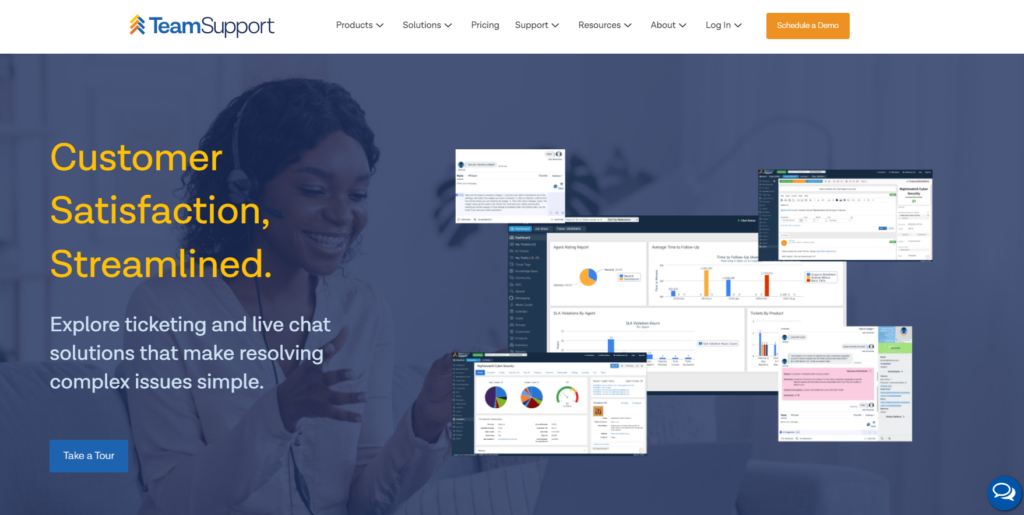
TeamSupport shines as a viable Help Scout alternative, particularly in the B2B landscape. It brings to the table features such as task management, role-based permissions, and call center management, which are absent in Help Scout. These features contribute to enhanced team efficiency and more controlled access to resources.
The user-friendly interface of TeamSupport and its reliable customer support stand out as positive aspects. While there’s room for improvement in areas like customization and reporting, these don’t overshadow the benefits it offers.
TeamSupport strikes a fine balance between advanced features and user-friendly operation, making it a worthwhile Help Scout alternative.
TeamSupport features
Features common to TeamSupport and Help Scout:
- Ticket management
- Customer database
- Knowledge base
- API
- Email management
- Multi-channel communication
- Live chat
Features not present in Help Scout:
- Task management
- Role-based permissions
- Call center management
- SLA
What are the main differences between TeamSupport and Help Scout?
- Task management: TeamSupport offers task management capabilities, a feature not present in Help Scout. This allows for better organization of tasks, streamlining workflows, and boosting productivity within customer support teams.
- Role-based permissions: With TeamSupport, you can assign role-based permissions. This is a feature Help Scout also offers, however, TeamSupport’s functionality is more advanced. It helps businesses manage user access based on their roles, ensuring better security and accountability.
- Call center management: Unlike Help Scout, TeamSupport includes call center management. This tool can be essential for businesses that rely on phone support, as it can significantly enhance the efficiency and effectiveness of their call centers.
Pros
- The interface is user-friendly and straightforward
- Exceptional customer support provides timely and effective assistance
Cons
- Limited customization may restrict full adaptation to specific business needs
- Reporting capabilities could be more expensive to provide more detailed insights
Best for medium to large businesses
TeamSupport is ideal for B2B businesses like IT services and software industries who benefit from its project management capabilities, and manufacturing businesses that appreciate its robust collaborative tools for efficient inter-departmental efforts and customer service.
TeamSupport pricing
TeamSupport proposes a free trial along with three key pricing plans.
- Chat Support plan is available at $29 per agent/month
- Essential Support plan is available at $35 per agent/month
- Professional Support plan is priced at $49 per agent/month
- Enterprise Support Suite comes with custom pricing
Check out a full TeamSupport alternative comparison and find out how it holds up against LiveAgent.
5. Freshdesk
Freshdesk, a product from Freshworks, is a dynamic cloud-based customer service platform and a formidable alternative to Help Scout. Freshdesk integrates with a wide array of third-party applications, including Slack, Mailchimp, Shopify, and Zoom, creating a flexible and streamlined workflow.
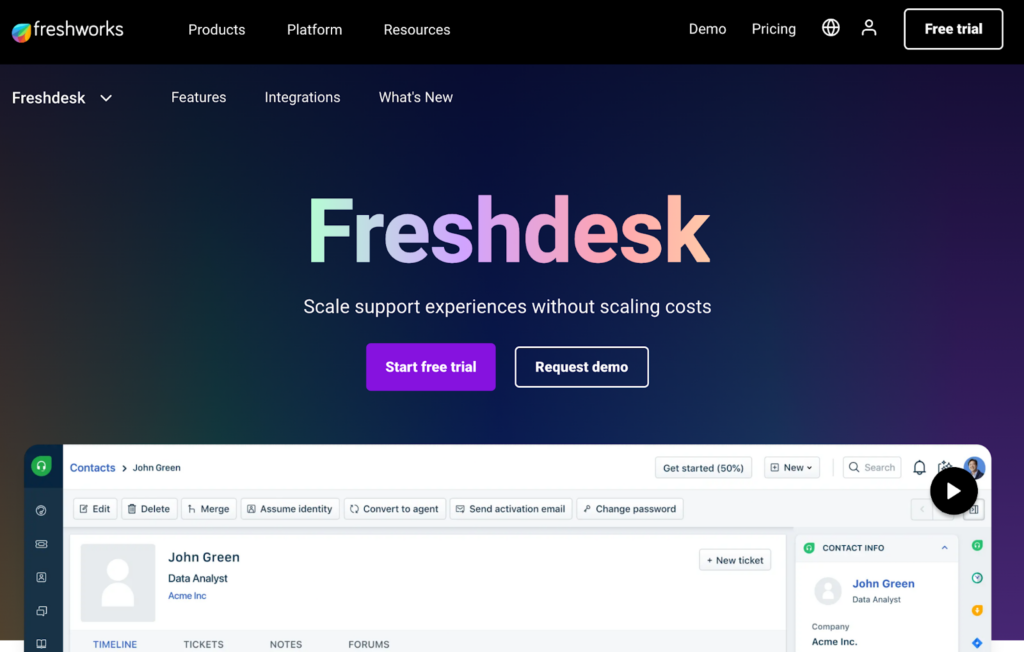
Freshdesk’s capabilities include SLA management, social media integration, and call center management, Freshdesk presents an extensive, well-rounded offering that steps beyond what Help Scout provides.
Where Freshdesk truly excels is in its intuitive interface and consistent customer support, which are key elements integral to an effective helpdesk solution. Its limitations, such as pricing and reporting, do not overshadow its potential and value for businesses.
Freshdesk features
Features common to Freshdesk and Help Scout:
- Ticketing system
- Live Chat
- Customizable branding
- API
- Knowledge base management
- Mobile access
- Tagging
- Surveys
Features not present in Help Scout:
- SLA
- Social media integration
- Call Center Management
- Freddy AI
What are the main differences between Freshdesk and Help Scout?
- SLA management: Freshdesk stands out with its SLA management feature, enabling businesses to consistently meet service standards. This critical aspect is absent in Help Scout, making Freshdesk a more reliable option for businesses that prioritize adhering to service-level agreements.
- Social media integration: Freshdesk enhances customer interaction by integrating with several social media platforms, a feature that Help Scout lacks. This gives Freshdesk an upper hand in reaching customers where they are most active and providing versatile multi-channel support.
- Call center management: Unlike Help Scout, Freshdesk includes call center management. This feature facilitates seamless integration of phone support into the customer service platform, providing a more comprehensive solution for businesses relying significantly on telephonic support.
Pros
- The interface is easy to navigate and use effectively
- Many integration options that are simple to set up
- Robust reporting features and analytics provide valuable insights
Cons
- Freddy AI is accessible only in higher pricing tiers
- Limited UI customization
- Occasional slow response times and bugs on the website
Best for small to medium-sized businesses
Freshdesk excels in the retail and e-commerce sector due to its multi-channel support, and in the travel and hospitality industry for its Service Level Agreement (SLA) management feature, enhancing customer service experiences consistently.
Freshdesk pricing
Freshdesk comes with a 21-day free trial and several pricing tiers to suit a variety of requirements.
- Free
- Growth costs €15 per agent/month, provides enhanced features.
- Pro costs €49 per agent/month
- Enterprise costs €79 per agent/month
Check out a full Freshdesk alternative comparison and find out how it holds up against LiveAgent.
6. Zoho Desk
Zoho Desk stands out as a feature-rich, cost-effective alternative to Help Scout. As part of the comprehensive Zoho suite, it offers a well-integrated help desk solution with advanced AI capabilities. Zoho Desk provides seamless integration with a host of Zoho apps and third-party platforms like Slack, Google Workspace, and Microsoft Teams, creating a comprehensive and unified workspace.
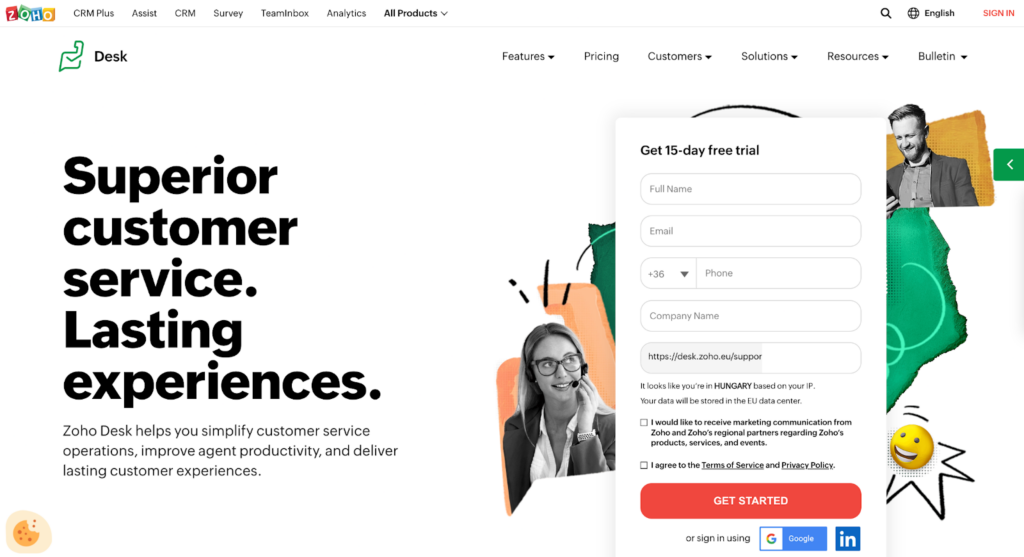
Zoho Desk shines as a compelling Help Scout alternative, boasting advanced AI capabilities, comprehensive dashboards, and wide integration options. Its features like real-time analytics, SLA management, and AI assistance offer businesses a high degree of oversight and efficiency in customer service management.
The comprehensive, unified workspace of Zoho Desk, coupled with its seamless integrations, are commendable. However, limited customization and a somewhat confusing interface may pose challenges. Either way, these factors don’t detract from its overall benefits.
Zoho Desk features
Features common to Zoho Desk and Help Scout:
- Ticketing system
- Live chat
- Feedback management
- API
- Knowledge base management
- Multi-channel communication
- Mobile access
- Automated routing
Features not present in Help Scout:
- Real-time analytics
- Call center management
- SLA
- Chatbot
What are the main differences between Zoho Desk and Help Scout?
- Real-time analytics: Zoho Desk provides real-time analytics, a feature absent in Help Scout. This allows businesses to monitor and track customer interactions in real-time, leading to more effective decision-making.
- SLA: Zoho Desk offers Service Level Agreement (SLA) capabilities, ensuring businesses maintain high-quality service consistently, a feature that Help Scout lacks. This makes Zoho Desk a more reliable option for businesses that must adhere to strict service standards.
- AI chatbot: Zoho Desk goes a step further by integrating AI into its platform, enabling more efficient customer service processes. This feature sets Zoho Desk apart from Help Scout, which does not include an AI chatbot.
Pros
- The software is being continuously updated for better performance
- Helpful comprehensive dashboards
- It’s easy to integrate within the Zoho ecosystem
Cons
- Limited UI customization options
- The interface may be confusing for first-time users
- Missing end-user alerts when a ticket is forwarded to another agent
Best for medium to large businesses
Zoho Desk, an AI-enhanced platform, simplifies customer service for technology and software businesses. For e-commerce, its real-time analytics provides immediate insights into customer interactions, enabling swift adaptations to customer needs. It is ideal for businesses leveraging other Zoho products.
Zoho Desk pricing
Zoho Desk provides a flexible free trial along with several pricing plans.
- Standard plan costs €14 per agent/month
- Professional costs €23 per agent/month
- Enterprise plan costs €40 per agent/month
Check out a full Zoho Desk alternative comparison and find out how it holds up against LiveAgent.
7. Intercom
Intercom, a conversational relationship platform, offers a unique approach to customer support, making it a notable alternative to Help Scout. It provides integration with numerous popular tools such as Slack, Google Analytics, HubSpot, Salesforce, and more, to ensure a smooth workflow.
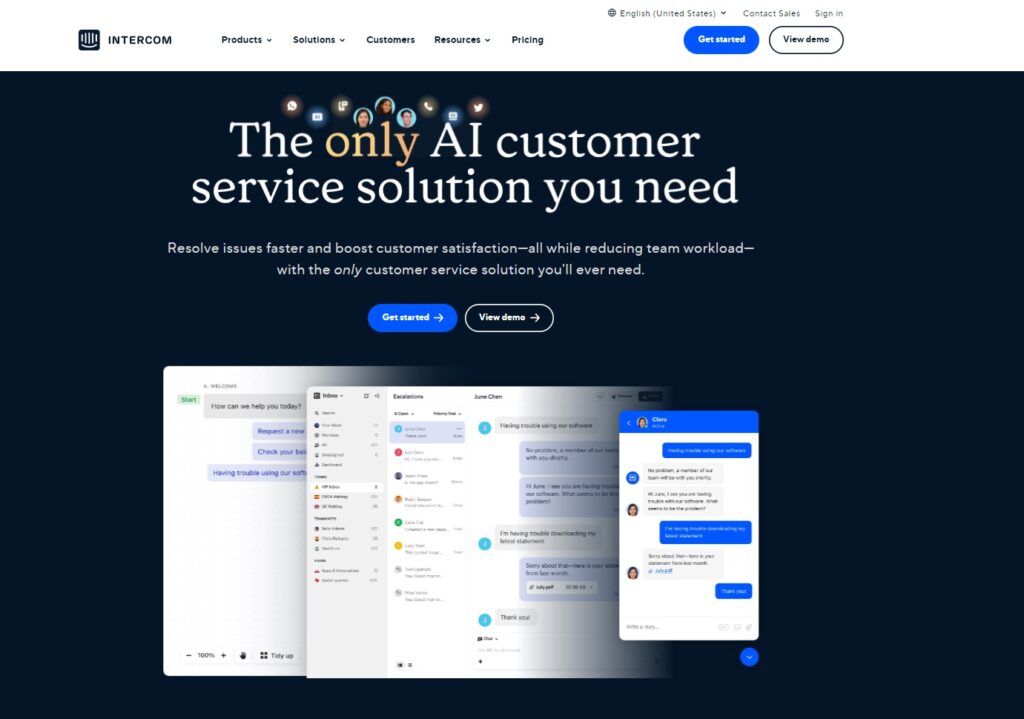
Intercom distinguishes itself as a potent alternative to Help Scout, emphasizing real-time, personalized customer engagement. Its advanced automation and audience targeting capabilities enable businesses to optimize customer interactions and build meaningful relationships.
Intercom’s integration with popular tools enhances workflow continuity, though it’s noteworthy that the learning curve can be steep and the cost may become substantial with added functionalities. Still, these challenges do not significantly diminish its overall utility.
Intercom features
Features common to Intercom and Help Scout:
- Ticket management
- Live chat
- API
- Knowledge base management
- Multi-channel communication
- Mobile access
- Queue management
- Email management
Features not present in Help Scout:
- Audience targeting
- Advanced automation
- Self-service tools
- SLA
What are the main differences between Intercom and Help Scout?
- Audience targeting: Intercom distinguishes itself with audience targeting capabilities, enabling businesses to segment and personalize customer interactions. This feature, which is absent in Help Scout, empowers businesses to tailor their support and marketing efforts to specific user groups.
- Advanced automation: Intercom steps up with its advanced automation features, allowing businesses to automate routine tasks and provide faster, more efficient customer support.
- Self-service tools: Intercom provides customers with an array of self-service tools, allowing them to find solutions to common issues without contacting support. This aspect, not present in Help Scout, enhances customer empowerment and reduces the workload of support teams.
Pros
- Modern and intuitive interface
- Advanced automation and use of AI
- The platform supports many media options – CSS, HTML, .gif, etc.
Cons
- The subscription options are quite expensive
- Advanced features require a steep learning curve
- The knowledge base is relatively limited
Best for businesses of all sizes
Intercom, with its advanced features, streamlines customer interaction, making it ideal for e-commerce businesses and marketing sectors. It boosts real-time customer inquiries resolution for e-commerce, while for marketing and advertising, it enables effective audience targeting for enhanced conversion rates.
Intercom pricing
Intercom presents a 14-day free trial alongside a variety of pricing options tailored to various needs.
- Starter package is priced at $39/seat/month
- Pro costs $99/seat/month
- Premium costs $139/seat/month
Check out a full Intercom alternative comparison and find out how it holds up against LiveAgent.
8. Zendesk Suite
Zendesk Suite is a unified customer service tool known for its holistic approach to customer support. It integrates effortlessly with an array of apps and platforms like Slack, Salesforce, Jira, Google Workspace, and more, greatly enhancing team productivity.
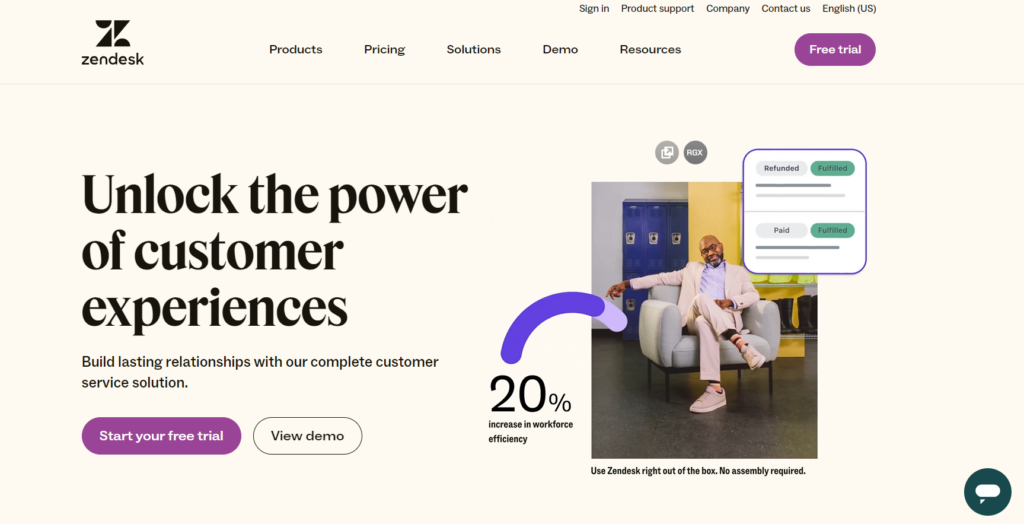
Zendesk Suite emerges as a compelling alternative to Help Scout, boasting features such as real-time analytics, an internal knowledge base, and wide-reaching social media integration. Its ability to provide a unified workspace and seamless integration with various platforms makes it stand out among customer service solutions.
While Zendesk Suite offers a wide array of advanced features, it’s worth noting that these are predominantly available in higher-tiered plans. Additionally, customization might require some technical know-how, potentially posing a challenge.
Zendesk Suite features
Features common to Zendesk Suite and Help Scout:
- Multi-channel communication
- Customer self-service portal
- Live chat and messaging
- API
- Email management
- Mobile access
- Multi-channel communication
- Automated routing
Features not present in Help Scout:
- Help desk ticketing
- Internal knowledge base
- Real-time analytics and reporting
- Social media integration
What are the main differences between Zendesk Suite and Help Scout?
- Internal knowledge base: Zendesk Suite features an internal knowledge base that facilitates knowledge sharing and collaboration among team members. This is a feature not present in Help Scout.
- Real-time analytics and reporting: While both platforms offer some level of analytics and reporting, Zendesk Suite takes it a step further by providing real-time analytics and reporting. This feature helps businesses monitor their customer service performance and make data-driven decisions.
- Social media integration: Zendesk Suite supports wider integration with social media platforms, enabling businesses to manage customer interactions across multiple channels.
Pros
- User-friendly interface ensures ease of use
- Comprehensive reporting and analytics for insightful decision-making
Cons
- Top-tier features only available in pricier plans
- Customization might demand a degree of technical knowledge
Best for medium to large businesses
Zendesk Suite offers retail businesses multi-channel communication, enhancing customer interaction and experience. For financial institutions, it provides robust security and an internal knowledge base, ensuring secure customer engagement and informed internal teams.
Zendesk Suite pricing
Zendesk Suite provides several pricing options, each coming with a free trial.
- The Suite Team plan costs €55 per agent per month,
- The Suite Growth plan is €89 per agent per month,
- The Suite Professional plan stands at €115 per agent per month.
Check out a full Zendesk alternative comparison and find out how it holds up against LiveAgent.
9. Front
Front is a collaborative inbox platform that brings together all your communication channels into one place, making it an excellent alternative to Help Scout. It integrates with numerous popular platforms such as Asana, Salesforce, HubSpot, and more, ensuring seamless workflows and increased productivity.
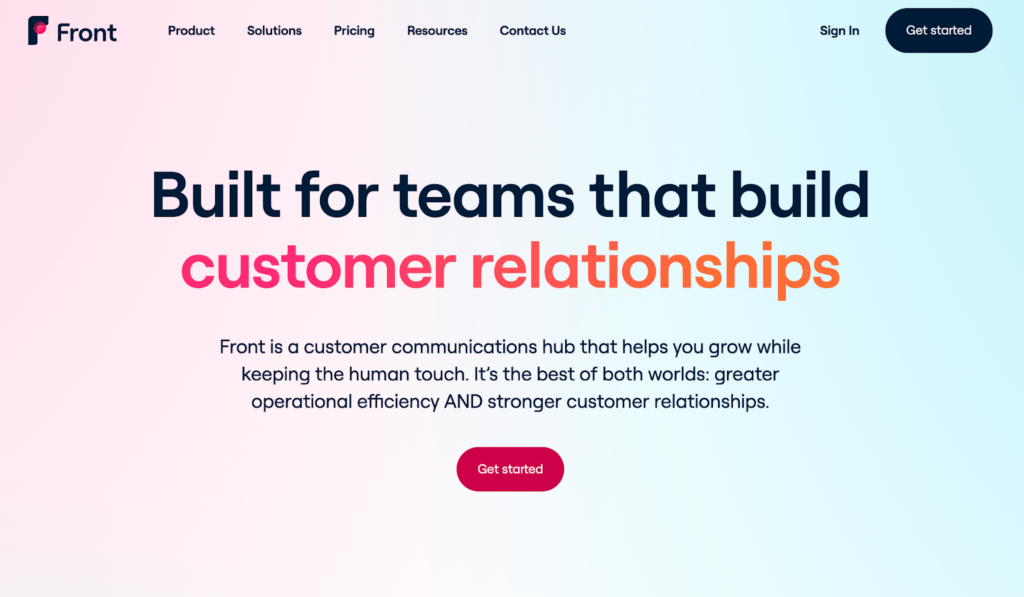
Front stands out as a compelling alternative to Help Scout, offering an excellent unified platform for managing all communication channels. Its advanced features like call center management, chatbots, and SLA management offer businesses a comprehensive and streamlined customer service solution.
Despite a somewhat steep learning curve and limited customization, the overall benefits of using Front cannot be undermined. Its automation capabilities and analytics tools provide valuable insights, increasing the efficiency of customer service processes.
Front features
Features common to Front and Help Scout:
- Live chat feature
- Ticket management
- Reporting and analytics
- API
- Knowledge base management
- Mobile access
- Automated routing
- Multi-channel communications
Features not present in Help Scout:
- Call center management
- Chatbot
- SLA
- Client portal
What are the main differences between Front and Help Scout?
- Call center management: Unlike Help Scout, Front provides call center management features, making it easy to handle phone support along with other communication channels. This offers businesses a more comprehensive customer support solution.
- Chatbot: Front comes equipped with chatbot functionality that can automatically respond to customer queries, guide customers, and even automate certain tasks. This feature is not present in Help Scout, which relies on human intervention for all customer interactions.
- SLA (Service Level Agreement) management: Front also provides SLA management features, allowing businesses to manage and meet their service level commitments to customers. In contrast, Help Scout does not have a built-in SLA management feature.
Pros
- Easy team collaboration using a shared inbox
- Helpful ticket automation options
- Analytics dashboard provides valuable insights
Cons
- Limited UI customization options
- Steep learning curve
- Some may find the tagging functionality restrictive
Best for medium to large businesses
Tech startups can immensely benefit from Front’s unified inbox feature, streamlining customer communication and fostering collaboration. For e-commerce platforms, Front’s multi-channel support and call center management enhance customer experience by managing sizable customer interactions.
Front pricing
Front presents a range of pricing plans, accompanied by a 7-day free trial. The options are:
- Starter plan at $19 per agent per month,
- Growth plan at $59 per agent per month,
- Scale plan at $99 per agent per month,
- Premier plan at $229 per agent per month.
Check out a full Front alternative comparison and find out how it holds up against LiveAgent.
10. Crisp
Crisp is a help desk software designed to streamline customer service processes. It offers a wide range of features including live chat, help desk, knowledge base, customer segmentation and chatbot functionalities. Notably, Crisp can be integrated with a variety of platforms such as Slack, Telegram, Email and Facebook Messenger, to improve customer service handling. This capability makes it an adaptable tool for different business sizes and types.
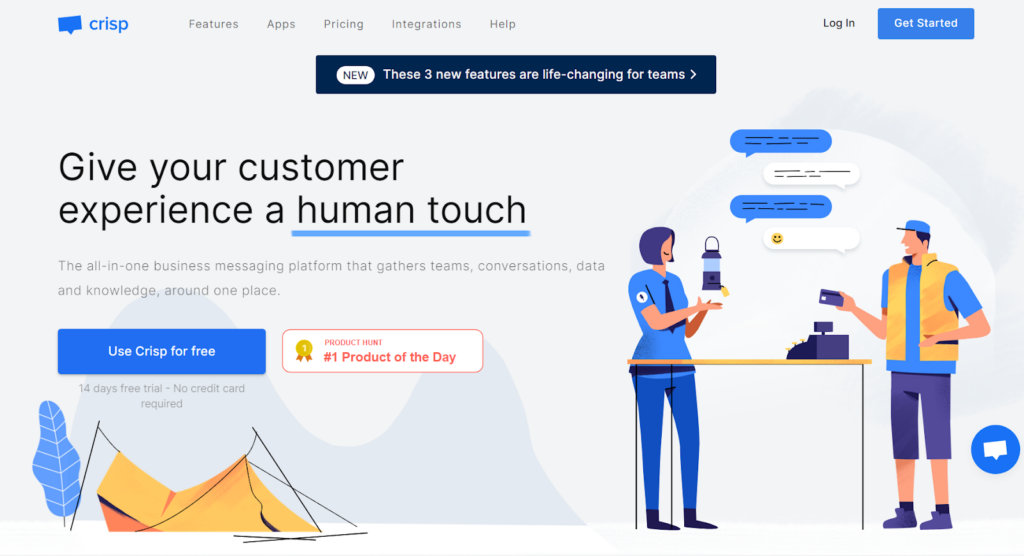
Crisp offers a streamlined user interface, facilitating easy navigation and rapid response times, which is a great advantage in customer service. It also offers comprehensive options for communication channels. However, its automation features need enhancement for more complex needs and navigating between conversations could be made smoother. Performance glitches with larger ticket volumes is also an area of improvement. Although the tool provides substantial customer support, there is a slight learning curve for beginners. Nonetheless, Crisp stands as a user-friendly and practical option for small to mid-size businesses.
Crisp features
Features common to Crisp and Help Scout:
- Chat system
- Customizable branding
- Multi-channel customer support
- Team collaboration
- Analytics
- Segmentation
Features not present in Help Scout:
- Automatic triggers
- Campaign builder
- Built-in status page
What are the main differences between Crisp and Help Scout?
- Features: Crisp offers live chat, email, social media integration, CRM capabilities, and even chat bot functionality. It integrates with several business apps and provides real-time visitor tracking. On the other hand, Help Scout includes features like shared inbox, live chat, and a help desk system. It also offers phone support and reporting features which Crisp does not.
- Target users: Crisp is particularly suited for small to medium businesses and startups who prefer a cost-effective solution with straightforward functionality. Help Scout is better suited for larger businesses or those who require more advanced reporting and customer management tools.
- Customization: Help Scout allows more customization in terms of personalizing messages, workflows and more. Crisp, while it has customization options, is not as flexible.
Pros
- User-friendly interface
- Reliable customer support
- Responsive mobile app
Cons
- Occasionally not receiving notifications
- Limited customization
- Lack of ticket sharing features
Best for small to medium-sized businesses
Crisp’s help desk software is ideal for small to medium-sized businesses, particularly those in the tech or e-commerce industries. These businesses often require efficient and quick customer interaction, which Crisp can provide with its real-time chat support and multi-channel communication features.
Crisp pricing
Crisp offers three main pricing tiers:
- Free
- Pro for €25 month/per workspace
- Unlimited for €95 month/per workspace
Check out a full Crisp alternative comparison and find out how it holds up against LiveAgent.
Key integration features of top Help Scout alternatives
Understanding the integration capabilities of customer service platforms is essential to finding an ideal Help Scout alternative. Many of these alternatives boast a variety of integrations to improve workflow and customer service management.
For instance, LiveAgent stands out with over 200 integrations, including:
- Shopify
- Slack
- Salesforce
- Gmail
- Zapier
- WordPress
- Mailchimp
- Pipedrive
On the other hand, HubSpot Service Hub integrates with platforms such as:
- Slack
- Gmail
- Salesforce
Jira Service Management ensures a fluid workflow with integrations like:
- Slack
- Confluence
- Opsgenie
- Bitbucket
TeamSupport optimizes its functionality with:
- Salesforce
- Zoho CRM
- Microsoft Teams
- Slack
Freshdesk amplifies its offering with integrations such as:
- Slack
- Mailchimp
- Shopify
- Zoom
All these Help Scout alternatives offer diverse integration capabilities, crucial for enhanced productivity and efficiency. Understanding these features and aligning them with your business requirements is vital in your choice of a customer service platform.
Which Help Scout competitors offer 24/7 customer support?
The importance of 24/7 customer support in the SaaS industry cannot be overstated. Savvy companies recognize that it’s not just an additional feature; it’s a critical part of the overall service delivery and customer satisfaction process that makes a marked difference in a highly competitive landscape.
In the global economy, SaaS companies don’t just cater to a local client base but serve customers around the world and across various time zones. Imagine a scenario wherein a client in another part of the globe encounters a software issue in the middle of their workday, but they can’t get immediate support due to time difference. That would likely result in service disruption, decreased productivity, and ultimately, customer dissatisfaction. Therefore, the presence of round-the-clock customer support ensures that no matter where your customers are or when they encounter issues, help is always within reach.
These are the Help Scout alternatives that offer 24/7 support:
- LiveAgent
- HubSpot Service Hub
- Jira Service Management
- Freshdesk
- Zoho Desk
- Intercom
- Zendesk Suite
Conclusion
A key differentiator with Help Scout in contrast to many of its competitors often lies in its limitations. While Help Scout may be ideal for simpler customer service needs, it can sometimes lack scalability for rapid business growth. Equally, there can be fewer personalization options, and some users report needing additional integrations.
Meanwhile, LiveAgent brings to the table features like native chat integration, unified inbox and automation, although other platforms offer comparable functionalities as well. Pricing plans of LiveAgent also scale with business needs, appealing to operations of varied sizes.
Before deciding,take LiveAgent for a test drive with a 30-day free trial and experience first-hand how it can elevate your customer service game. With LiveAgent, you’re not just choosing a platform; you’re choosing a partner dedicated to helping you succeed.
Frequently Asked Questions
Do Help Scout alternatives offer multilingual support?
Absolutely. Many Help Scout alternatives, including LiveAgent, offer multilingual support. This allows businesses to communicate effectively with customers around the globe, eliminating language barriers and improving overall customer experience.
How does LiveAgent's chat widget speed compare to Help Scout's?
LiveAgent's chat widget is faster than Help Scout's due to its superior technology and advanced architecture. It loads 2.5 times faster, taking only 2.5 seconds to completely load, compared to Help Scout's 6.3 seconds. This not only offers a better user experience but also retains customers more effectively.
How easy is it to migrate from Help Scout to LiveAgent?
The migration process from Help Scout to LiveAgent is designed to be smooth and hassle-free. LiveAgent provides comprehensive support and guidance throughout the process, ensuring your transition is seamless and your business experiences minimal downtime. The goal is to get your new customer service platform up and running as quickly and efficiently as possible.
Is Help Scout a CRM?
Yes, Help Scout is considered a Customer Relationship Management (CRM) system. It aids businesses in managing their customer communications and delivering excellent customer service. However, it is more specifically known as a help desk software with CRM features.
Share this article
Customer communication management software
LiveAgent customer communication management software will provide personalized, quick, and knowledgeable service to your customers. Try it for free.
The right help dek for every business
LiveAgent is a help desk software that adapts to the needs of different business models. Explore how LiveAgent fits your niche. Agency Edu and NGOs rely on LiveAgent.

 Български
Български  Čeština
Čeština  Dansk
Dansk  Deutsch
Deutsch  Eesti
Eesti  Español
Español  Français
Français  Ελληνικα
Ελληνικα  Hrvatski
Hrvatski  Italiano
Italiano  Latviešu
Latviešu  Lietuviškai
Lietuviškai  Magyar
Magyar  Nederlands
Nederlands  Norsk bokmål
Norsk bokmål  Polski
Polski  Română
Română  Русский
Русский  Slovenčina
Slovenčina  Slovenščina
Slovenščina  简体中文
简体中文  Tagalog
Tagalog  Tiếng Việt
Tiếng Việt  العربية
العربية  Português
Português 